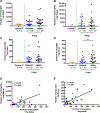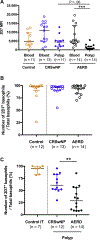Studies of the role of basophils in aspirin-exacerbated respiratory disease pathogenesis
- PMID: 33819512
- PMCID: PMC8355049
- DOI: 10.1016/j.jaci.2021.02.045
Studies of the role of basophils in aspirin-exacerbated respiratory disease pathogenesis
Abstract
Background: Aspirin-exacerbated respiratory disease (AERD) is characterized by the triad of chronic rhinosinusitis with nasal polyps (CRSwNP), asthma, and intolerance to cyclooxygenase-1 enzyme inhibitors. The underlying mechanisms contributing to AERD pathogenesis are not fully understood, but AERD is characterized by an enhanced type 2 inflammatory phenotype. Basophils are potent type 2 effector cells, but their involvement in AERD pathophysiology remains unclear.
Objective: We sought to characterize the systemic and local basophil responses in patients with AERD compared with patients with CRSwNP.
Methods: Sinonasal tissues including inferior turbinate and/or nasal polyps (NPs) and peripheral blood were collected from controls, patients with AERD, and patients with CRSwNP. Expression of cell surface (CD45, FcεRI, CD203c), activation (CD63), and intracellular (2D7) markers associated with basophils was characterized using flow cytometry. Clinical data including Lund-Mackay scores and pulmonary function were obtained.
Results: The mean number of basophils (CD45+CD203c+FcεRI+CD117-) detected in AERD NPs (147 ± 28 cells/mg tissue) was significantly elevated compared with that detected in CRSwNP NPs (69 ± 20 cells/mg tissue; P = .01). The number of circulating basophils was significantly elevated in patients with AERD (P = .04). Basophils in NPs had significantly higher CD203c and CD63 mean fluorescence intensity compared with blood in both conditions (P < .01). Basophils from AERD NPs had lower expression of the granule content marker 2D7 compared with those from matched blood (P < .01) or NPs of patients with CRSwNP (P = .06), suggesting ongoing degranulation. Basophil 2D7 mean fluorescence intensity significantly correlated with pulmonary function (r = 0.62; P = .02) and inversely correlated with sinonasal inflammation (r = -0.56; P = .004).
Conclusions: Increased basophil numbers and extent of ongoing degranulation in NPs of patients with AERD compared with patients with CRSwNP may contribute to the exaggerated disease pathogenesis and severity unique to AERD.
Keywords: 2D7; AERD; Aspirin-exacerbated respiratory disease; CRSwNP; basophil; chronic sinusitis; nasal polyp.
Copyright © 2021 American Academy of Allergy, Asthma & Immunology. Published by Elsevier Inc. All rights reserved.
Figures






Similar articles
-
Microparticles in nasal lavage fluids in chronic rhinosinusitis: Potential biomarkers for diagnosis of aspirin-exacerbated respiratory disease.J Allergy Clin Immunol. 2017 Sep;140(3):720-729. doi: 10.1016/j.jaci.2017.01.022. Epub 2017 Feb 24. J Allergy Clin Immunol. 2017. PMID: 28238741 Free PMC article.
-
Clinical Characteristics of Patients with Chronic Rhinosinusitis with Nasal Polyps, Asthma, and Aspirin-Exacerbated Respiratory Disease.J Allergy Clin Immunol Pract. 2017 Jul-Aug;5(4):1061-1070.e3. doi: 10.1016/j.jaip.2016.12.027. Epub 2017 Mar 9. J Allergy Clin Immunol Pract. 2017. PMID: 28286156 Free PMC article.
-
Cytokines in Chronic Rhinosinusitis. Role in Eosinophilia and Aspirin-exacerbated Respiratory Disease.Am J Respir Crit Care Med. 2015 Sep 15;192(6):682-94. doi: 10.1164/rccm.201412-2278OC. Am J Respir Crit Care Med. 2015. PMID: 26067893 Free PMC article.
-
Clinical and mechanistic advancements in aspirin exacerbated respiratory disease.J Allergy Clin Immunol. 2025 May;155(5):1411-1419. doi: 10.1016/j.jaci.2025.03.006. Epub 2025 Mar 18. J Allergy Clin Immunol. 2025. PMID: 40113018 Review.
-
Local immunoglobulin production in nasal tissues: A key to pathogenesis in chronic rhinosinusitis with nasal polyps and aspirin-exacerbated respiratory disease.Ann Allergy Asthma Immunol. 2021 Feb;126(2):127-134. doi: 10.1016/j.anai.2020.09.016. Epub 2020 Oct 13. Ann Allergy Asthma Immunol. 2021. PMID: 33065294 Free PMC article. Review.
Cited by
-
Aspirin hypersensitivity diagnostic index (AHDI): In vitro test for diagnosing of N-ERD based on urinary 15-oxo-ETE and LTE4 excretion.Allergy. 2025 Feb;80(2):534-544. doi: 10.1111/all.16281. Epub 2024 Aug 23. Allergy. 2025. PMID: 39180224 Free PMC article.
-
Non-eosinophilic asthma in nonsteroidal anti-inflammatory drug exacerbated respiratory disease.Clin Transl Allergy. 2023 Mar;13(3):e12235. doi: 10.1002/clt2.12235. Clin Transl Allergy. 2023. PMID: 36973957 Free PMC article.
-
Mechanistic and clinical updates in AERD: 2021-2022.J Allergy Clin Immunol. 2023 Jun;151(6):1448-1456. doi: 10.1016/j.jaci.2023.03.015. Epub 2023 Mar 24. J Allergy Clin Immunol. 2023. PMID: 36967016 Free PMC article.
-
Anti-IgE therapy in chronic rhinosinusitis with nasal polyps.J Allergy Clin Immunol. 2025 Jan;155(1):24-30. doi: 10.1016/j.jaci.2024.11.011. Epub 2024 Nov 16. J Allergy Clin Immunol. 2025. PMID: 39551440 Free PMC article. Review.
-
Role of Basophils in a Broad Spectrum of Disorders.Front Immunol. 2022 May 27;13:902494. doi: 10.3389/fimmu.2022.902494. eCollection 2022. Front Immunol. 2022. PMID: 35693800 Free PMC article. Review.
References
-
- Rajan JP, Wineinger NE, Stevenson DD, White AA. Prevalence of aspirin-exacerbated respiratory disease among asthmatic patients: a meta-analysis of the literature. J Allergy Clin Immunol 2015;135:676–81.e1. - PubMed
-
- Wang X, Zhang N, Bo M, Holtappels G, Zheng M, Lou H, et al.Diversity of TH cytokine profiles in patients with chronic rhinosinusitis: a multicenter study in Europe, Asia, and Oceania. J Allergy Clin Immunol 2016;138:1344–53. - PubMed
-
- Van Zele T, Claeys S, Gevaert P, Van Maele G, Holtappels G, Van Cauwenberge P, et al.Differentiation of chronic sinus diseases by measurement of inflammatory mediators. Allergy 2006;61:1280–9. - PubMed
Publication types
MeSH terms
Substances
Grants and funding
LinkOut - more resources
Full Text Sources
Other Literature Sources
Medical
Research Materials
Miscellaneous

